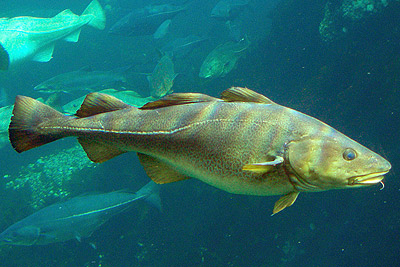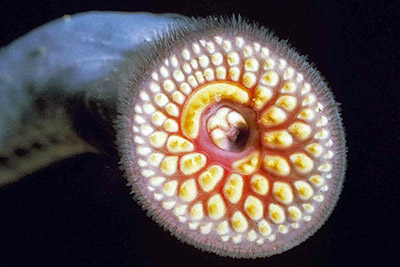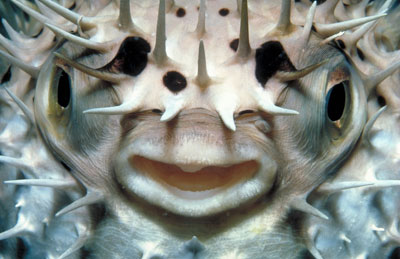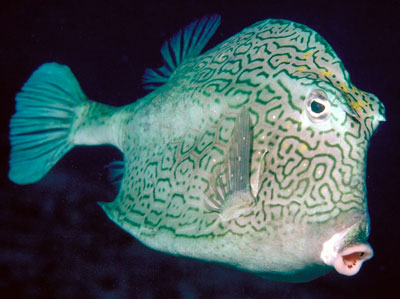Fish are the oldest of the vertebrate groups and have the greatest number of species currently identified at around 33,100 . They live almost anywhere there is enough water, from the highest mountain streams right down to the deepest ocean abyss. Almost all are cold blooded, able to turn the coldest most uninviting waters into areas of high productivity.
Pisces - Fish
Typical Fish

Atlantic Cod,
Gadus morhua - Gadiformes.
An important food fish for over 1000 years, cod have
been overfished and the previous enormous stocks have
collapsed, recently cod farming has been successful.
Photo: Hans-Petter Fjeld,
published under CC3
Attribution ShareAlike License

Coral Grouper or vermillion Seabass,
Cephalopholis miniata (Perciformes) - a carnivore
about 30-40cm long

Mouth of a Sea Lamprey
- Cyclostomata
A jawless fish, lampreys
are parasitic on larger fish, they attach themselves
to their host and rasp at tissue with the teeth and/or
feed on blood, letting go when they have had enough.

Lion fish, Pterois sp. (Scorpaeniformes)
A reef fish with poisonous spines, predatory on small
fish and invertebrates, can often be seen at night near
to lights by the sea that draw its prey. If diving or
snorkeling towards dusk they can emerge in surprising
numbers from nooks and crevices, sometimes rather shockingly
appearing if flushed out by another fish diving for
cover with its spines erect as defence.

A Parrotfish, the group is considered
to be a subfamily of the Wrasses. These fish
have a particular arrangement of their teeth that looks
like a parrots beak. They feed on algae that grows on
coral and when diving or snorkeling can be heard grinding
and rasping away at the coral underwater. The coral
passes through them and is deposited as coral sand which
helps build reefs and islands over time. Most parrotfish
start off life as females, and then become male later
in life.
-sm.jpg)
A Hammerhead Shark -
Elasmobranchii - a cartilaginous fish. One
of the defining characters can be seen clearly, the
heterocercal (asymmetrical) tail.
Cool Fish

A puffer fish or blowfish
- Tetraodontiformes - amongst many other names.
When threatened, these fish are able to take in a large
volume of water (not air) to blow themselves up to nearly
spherical at which point the spines point outwards.
These fish are also amongst the most poisonous vertebrates
in the world having enough tetrodotoxin to kill a human. They are highly prized to eat known as Fugu, chefs who prepare them are controlled by law in Japan and several other countries where they are eaten.

A file fish - Tetraodontiformes -
Found usually in shallow water of 30m or less and
frequently in or around coral reefs. Not great distance
swimmers but very maneuverable as the pair I watched
shredding a large jellyfish while snorkeling in the
Red Sea demonstrated.

A Manta Ray, Manta Birostris
- Elasmobranchii.
The largest of the rays,
mantas can be over 6m (20 feet) across and weigh more
than a tonne. They are plankton feeders, gentle and
harmless despite their appearance and alternative name
of devilfish.
Kingdom - Animalia
Phylum - Chordata
Subphylum - Vertebrata
Class
- Pisces
Basic Features:
Pisces is a Class in the Subphylum
Vertebrata of
the Phylum Chordata, so they have all of the characteristics
of both of these groups in addition to the following:
- Skin covered in scales.
- Ectothermic, cold blooded.
- Soft shelled eggs that must be laid in water.
- External fertilization.
- All members are fully aquatic.
- Limbs modified into fins.
- Gas exchange through gills.
What do fish eat?
As in many animal groups, between them all fish eat a whole range of different foods. Some fish are specialists on just a few sorts while others are generalists. The specialists often have very highly adapted mouths and teeth to enable them to feed more efficiently on their particular types of food. Here are some examples amongst the variety of carnivores, omnivores and herbivores:
What eats fish?
Fish are an important part of many food chains and webs. Many terrestrial or partly terrestrial animals such as birds, bears, reptiles etc. also feed on fish so their food webs stretch beyond the water.
The biggest natural consumers of fish are other fish.
Most fish are not cared for by the parents, the eggs are fertilized externally and often left to drift in the water, particularly at sea, though may stick to rocks where in some cases the parents may waft water over them to ensure they survive and hatch. After hatching the care of even this small number of fish mainly stops and the young larval fish are on their own.
As fish start off so small, in large quantities (Atlantic cod lay around 5 million eggs in a single spawning for example) and are on their own, this means that they are eaten by all manner of other fish and invertebrates of all sizes with a huge mortality in the early larval stages particularly when they are part of the plankton.
The group includes:
The status of fish groups, whether they are Classes, Orders, infraorders, subclasses etc. is something that is currently changing and somewhat confusing as to what they should be called. I have named some of the major groups without saying which level the group is (class, order, etc.) as doubtless the hierarchy will change whereas the names are relatively constant. The following list is representative but not complete.
- Cyclostomata - no jaw so the mouth cannot close,
retractable teeth - hagfish and lampreys
- Elasmobranchii - no swim bladder, teeth in several
series, heterocercal (vertically asymmetrical) tail
- sharks and rays
- Sarcopterygii - fleshy finned fishes (ancestors
of tetrapods) - Coelocanths, lungfishes
- Actinopterygii - ray finned fishes, fins are
skin supported by a number of bony spines or rays
- Teleostei - moveable lower and upper jaw,
homcercal (symmetrical) tails - Most living
fishes are members of this group
- Anguilliformes, reduced fin number, dorsal, anal and caudal fin often fused to make a ribbon running much of the upper and lower length of the body - the true eels
- Clupeiformes, include many important food fish, usually silvery, schooling, plankton-eating and pelagic- herrings, sardines, anchovies
- Cypriniformes, mostly fresh-water - carp, goldfish, minnows
- Siluriformes, prominent barbels around the mouth which resemble the whiskers of a cat - catfish
- Protacanthopterygii
- Salmoniformes, all members spawn in fresh water, though many spend much of their lives in the sea - salmon, trout, char, graylings
- Esociformes, mainly ambush predators and highly adapted as such - pike
- Lampridiomorpha
- Lampriformes, oceanic pelagic feeders - oarfish, opah and ribbonfishes
- Paracanthopterygii
- Lophiiformes, a fleshy growth on the head of the fish is used a lure - anglerfish
- Gadiformes - cod, burbot, hake
- Acanthopterygii
- Mugiliformes, identifiable as they have two dorsal fins and no lateral line, detritivores - mullet
- Beloniformes, includes the flying fish which have greatly developed pectoral fins into wings for gliding
- Tetraodontiformes, mostly found in the sea around coral reefs, many departures from the normal streamlined fish shape - file fish, puffer fish, box fish, oceanic sunfish
- Pleuronectiformes, flatfish, asymmetrical fish, both eyes lie on one side of the head - halibut, flounders, plaice, sole
- Scorpaeniformes, - lion fish, scorpionfish, stone fish
- Perciformes 40% of all fish species - bass, cichlids, gobies, gouramis, mackerel, perch, tuna, bonito, whiting, wrasse
- Teleostei - moveable lower and upper jaw,
homcercal (symmetrical) tails - Most living
fishes are members of this group
Fish are a major source of protein for people too, wherever there is a body of water near where people live it will be fished for food (or was in the historical past).
The total world fisheries for human food, marine and freshwater is around 80 million tonnes per year! With another 13 million tonnes of invertebrate fishery, shrimps, squid, mussels etc.
Some of the groups of fish caught are:
| Fish group | Annual catch, millions of tonnes |
| Freshwater fish: miscellaneous | 6.80 |
| Salmon, trout, smelts | 1.03 |
| Marine demersal: cod, hake, haddock | 8.96 |
| Marine pelagic: herrings, sardines, anchovies | 22.40 |
| Marine pelagic: tunas, bonito, billfishes | 6.24 |
| Marine pelagic: miscellaneous | 11.18 |
| Sharks, rays, chimeras | 0.77 |
| Other marine | 9.56 |
Pelagic - fish that live in the water column or near the surface, free swimming.
Demersal - fish that live on or near the bottom of the water including coral reefs.
Fish profile - Atlantic bluefin tuna,
Thunnus thynnus - Perciformes

Tuna are amongst the most remarkable of fish, their adaptations
are predominantly directed to swimming quickly. They can swim
for sustained periods of 2-12 kmh (walking to jogging pace,
but in water) and reach burst speeds of up to 70 kmh. Tagging
studies have shown migrations of over 10,000km.
They
have a shape that is optimized to slip through the water. The
tail or caudal fin is held away from the body on a narrow region
called the caudal peduncle (I've always liked that name). The
separation of the tail fin from the body in this way aids streamlining
as the tail effectively acts as if was hydrodynamically separate
to the rest of the fish.
One of their most remarkable
adaptations to swimming is that they are partially warm-blooded.
Fish are generally ectothermic, they are the same temperature
as the environment and unable to thermoregulate (maintain a
steady temperature different to the environment). Tuna such
as the Atlantic Bluefin are able to maintain a temperature of
24-35C in their swimming muscles even in water temperature
down to 6C. Higher temperatures allow the biochemical reactions
required to proceed more rapidly. This temperature however is
not closely regulated as in endotherms such as mammals and birds
and varies quite considerably.
It is the deep red muscle
that is kept at a higher temperature, this runs the length of
the fish from the pectoral fin to the tail and forms about 10%
of the cross-sectional area of the fish. There are collections
of blood vessels called rete mirabile (Latin for "wonderful
net") that have the task of exchanging heat from warmed blood
flowing away from the muscle to colder blood flowing towards
the muscle. Thus the active muscle can be warmed up quickly
and kept warm without needing to heat up the whole body. This
system also has the advantage that heat can readily be lost
by adjusting the constriction of arteries and veins to dump
heat around the rest of the body if it builds up too much.
There are a number of tuna species of various sizes, though
they tend to be quite large fish. Commonly they are from 40-200cm
long at maturity with the largest being 300cm long and weighing
upwards of 650kg.
Recently discovered and filmed fish with a transparent
head
Manta Ray feeding in the Maldives
Top banner picture, Reef shark stalking a school of jack fish at Sipadan Island, Malaysia, picture courtesy Avoini, used under Creative Commons Attribution-Share Alike 3.0 Unported license.
